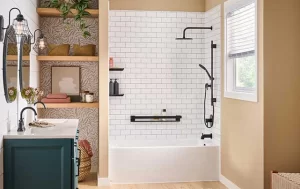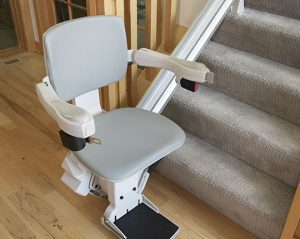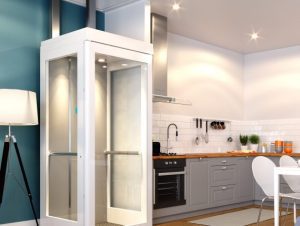Many older adults face the challenge of maintaining independence in their own homes as they age. A surprising fact is that over 90% of seniors prefer to stay in their homes rather than move to senior living communities.
This article offers practical tips and smart plans for making your home a safe, comfortable place to age in place. Discover how simple changes can make a big difference.
What Is Aging In Place?
Aging in place is the act of older adults living independently and comfortably in their own homes, rather than moving to a senior housing facility. It not only allows seniors to maintain their sense of dignity and independence but also encourages an active lifestyle while receiving necessary support.
Definition of aging in place
Aging in place means staying in your own home as you grow older, making it possible to maintain independence rather than moving to senior living facilities. Homeowners aim for a comfortable and safe environment that adapts to their changing needs over time.
This concept embraces the idea of living independently, utilizing smart technology, aging at home solutions, and modifications that ensure continued comfort and safety.
To successfully age in place, individuals often consider adaptive technology and accessibility upgrades customized for elderly care. These home modifications may include installing grab bars in bathrooms, adjusting counter heights for easier access, or incorporating senior-friendly home improvements.
The goal is to create an age-friendly home design that supports independent living for seniors through thoughtful aging in place design elements and assistive devices.
Benefits of aging in place
Understanding the concept of aging in place sets the stage for appreciating its numerous advantages. One of the most significant benefits is maintaining independence, as seniors have the freedom to live on their own terms and schedules in a familiar environment.
This autonomy often leads to improved mental health, as older adults feel more content and less stressed by being able to manage their day-to-day life without feeling like a burden to their families.
Moreover, aging in place can be more cost-effective than moving into senior living facilities. With strategic home modifications and smart technology integrations, homes can be adapted to meet the changing needs of seniors, ensuring they age comfortably and safely.
These adjustments not only enhance home comfort but also reduce the need for expensive long-term care services. Aging at home allows individuals to stay connected with their community, preserving relationships that are crucial for emotional support and well-being. Aging at home empowers seniors by offering them control over how they live out their later years.
Considerations for aging in place
Choosing to age in place brings forward several critical considerations that homeowners must evaluate to ensure safety and comfort remain paramount. Foremost among these is home modification.
Simple changes like installing grab bars in bathrooms, ensuring floors are slip-resistant, and making sure living spaces are easily accessible can make a significant difference. These adjustments aim for independent living, allowing seniors to move through their homes safely as they age.
Another vital consideration involves adopting aging in quality design principles and integrating smart technology solutions that support senior living at home. This may entail setting up voice-activated devices for easy communication or control over the house, installing sensors that monitor health and activity without being invasive, or employing emergency response systems created specifically for elderly care.
Such technologies not only enhance home comfort but also provide peace of mind to both the occupants and their families by promoting an environment where aging in place becomes a feasible option with the right resources and modifications in place.
Planning Ahead for Aging In Place
Plan ahead for aging in place by considering your financial situation and making necessary home modifications. Health considerations should also be factored into your plan to ensure a comfortable and safe living environment as you age.
Financial planning
When planning to age in place, it’s crucial to consider the financial aspects. According to a report by the AARP Public Policy Institute and the National Conference of State Legislatures, 90% of older adults prefer aging at home.
To make this possible, start by evaluating your current finances and expenses. Consider additional costs such as home modifications or hiring in-home care services if needed. It is advisable to create a budget specifically for aging in place, factoring in potential future healthcare expenses and long-term care insurance.
Furthermore, explore options like reverse mortgages or home equity loans that can help finance necessary home modifications and improvements for aging in place. Be sure to consult with a financial advisor or estate planner specialized in eldercare to develop a comprehensive plan tailored towards your specific needs and resources.
Home modifications
To ensure your home is safe and comfortable for aging in place, consider the following home modifications:
- Install grab bars in bathrooms and by stairs to provide support and prevent falls.
- Create a step-free environment with ramps or lifts for easy access.
- Modify kitchen cabinets to lower heights for easier reach and install lever-style door handles for convenience.
- Improve lighting throughout the house to reduce the risk of tripping and enhance visibility.
- Replace traditional bathtubs with walk-in showers or tubs with built-in seats for safety and comfort.
- Consider installing smart home technology such as voice-activated lights and thermostats for easier control.
These modifications can significantly enhance the safety and accessibility of your home, allowing you to age in place comfortably and independently.
Health considerations
When planning to age in place, it’s important to consider health factors that could affect your ability to stay at home safely and independently. As you prepare for aging in place, take into account any current health conditions or potential future needs that may require adaptations to your home.
Health considerations can include mobility issues, chronic illnesses such as arthritis or diabetes, vision and hearing impairments, cognitive decline, and the need for regular medical care.
By addressing these health concerns proactively, homeowners can make informed decisions about necessary modifications and support services.
Making Your Home Safe and Accessible
Ensure your home is safe and accessible for aging in place. Read more to learn how to create a comfortable living environment.
Home safety tips for older adults
As a homeowner, ensuring the safety of your senior loved ones is crucial. Here are some practical home safety tips to create a secure living environment for older adults:
- Install grab bars in key areas such as bathrooms, hallways, and near stairs to provide support and prevent falls.
- Ensure adequate lighting throughout the house, including night lights in bedrooms and bathrooms to improve visibility at night.
- Remove tripping hazards such as loose rugs or clutter from walkways.
- Consider installing handrails on both sides of stairways for added stability when navigating different levels of the home.
- Invest in non-slip flooring or apply non-slip coatings to existing floors in high-traffic areas to reduce the risk of slipping accidents.
- Keep commonly used items within easy reach to minimize the need for reaching or bending over, reducing strain on aging bodies.
- Utilize smart technology such as motion sensor lights and emergency response systems to provide quick assistance in case of accidents.
- Regularly inspect and maintain smoke detectors, carbon monoxide alarms, and other essential safety devices to ensure they are functioning optimally.
By implementing these home safety measures, you can help older adults live independently while minimizing potential hazards within their living space.
Necessary home modifications
To create a safe and comfortable environment for aging in place, consider the following necessary home modifications:
- Install grab bars in bathrooms and near stairs to provide stability and support for seniors as they move around their homes.
- Improve lighting by adding brighter bulbs and motion-sensor lights to reduce the risk of falls, especially during nighttime.
- Remove tripping hazards such as loose rugs or clutter on the floor to minimize the risk of accidents.
- Consider installing a walk-in shower or a bathtub with a transfer bench for easier access and reduced chance of slipping.
- Modify doorways to be wider to accommodate wheelchairs or walkers, enhancing overall accessibility within the home.
- Adjust countertop heights to make them more accessible for individuals with limited mobility or those using mobility aids.
- Replace traditional doorknobs with lever-style handles that are easier for older adults to grip and operate without straining.
- Create a single-level living space by minimizing stairs or adding ramps for easy navigation throughout the home.
Technology for aging in place
It’s important to consider how advancements in smart technology can support independent living for seniors.
From wearable health monitoring devices and medication reminder apps to smart home systems that can control lighting, temperature, and security features with voice commands or mobile applications – these technologies are designed to enhance safety, comfort, and accessibility for older adults aging at home.
With the help of adaptive technology and assistive devices, seniors can maintain their independence while staying connected with caregivers and medical professionals when needed.
In addition to these innovations, there is a growing market for products specifically tailored towards age-friendly home design and accessibility upgrades. These solutions not only offer convenience but also contribute significantly towards creating a safe environment that promotes senior well-being.
Contact Caliber Home Solutions for Aging in Place Solutions
In summary, embracing the concept of aging in place involves careful planning, thoughtful modifications, and utilizing resources to ensure a safe and comfortable home environment for seniors.
By integrating accessibility upgrades, smart technology, and adaptive devices into the home design, homeowners can promote independent living while addressing safety concerns. These practical strategies not only enhance the quality of life for aging individuals but also contribute to their overall well-being.
For those seeking more than just information on aging in place solutions, contact Caliber Home Solutions! Remember that achieving an age-friendly home is attainable through simple yet impactful changes.





